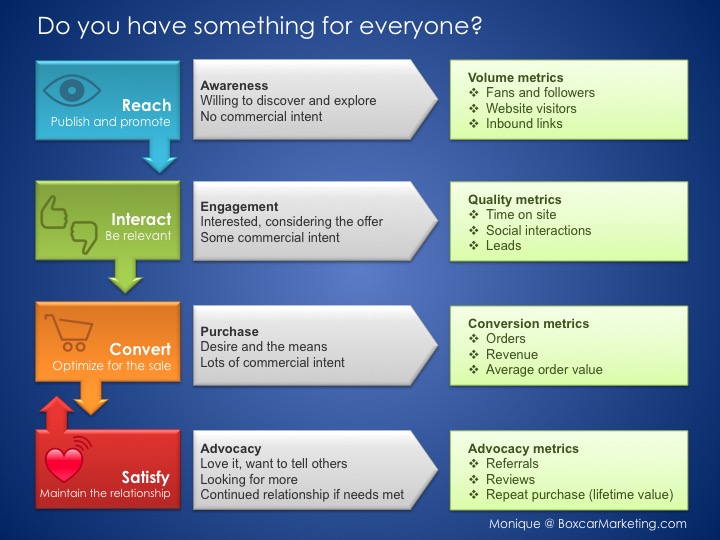Marketing’s job is to reach, interact, convert and satisfy an audience. Knowing the desired outcome at each stages helps you measure success accountably. See what to measure and why.

Measuring success is dependent on the goal of your marketing campaign. But too often marketers want a single campaign to be multipurpose. It’s possible for campaigns to have multiple outcomes, but ideally everyone on the marketing team is optimizing for a particular stage in the customer journey.
Consider these questions to determine your primary goal:
- Do you need to increase awareness of your offering (book, author, event, etc)?
- Do people know about the offering and you need to engage with that audience? i.e., Get them to like, comment, share, sign up, download, or otherwise take some sort of non-revenue based action to shows they are interested?
- Are people interested and engaged and you need to compel them to buy?
- Do you have a solid base of customers and you want to give them a reason to be loyal, repeat customers?
At this point, people often say, “we want all of that!” Yes, and you should have all of that. But think about it like party planning. What you organize and do for friends is different than the type of event you would organize for strangers. Marketing campaigns work best when there’s a distinct audience and series of actions that are suited to the audience’s knowledge and interest in what you have to offer. As Seth Godin says, you want to turn strangers into friends, and friends into advocates.
Here’s what I would measure and why.
1. Do you need to increase awareness of your offering?
When it’s familiarity with an author, topic or the book itself, awareness campaigns are about getting on the radar of people who have yet to hear about the offering but are likely to be interested. Typically, as marketers, we want people to know about a book or author. We also need to understand that this audience has little to no commercial intent (yet).
Actions: Publish and promote content on websites and social media. Draw people to your websites.
How do we measure success (remembering that this audience is in exploration mode not purchase mode)? Choose volume metrics.
- Fans and followers on social media
- Website visitors
- Inbound links
At this stage in outcomes-driven marketing you are answering: How effective are your marketing efforts in drawing an audience?
2. Do people know about the offering and you need to engage with that audience?
In other words, do you need to get your audience to like, comment, share, sign up, download or take some sort of non-revenue based action to show they are interested? Do you want them to spread the word? In an engagement campaign using a contest, this would include tracking contest entries, adding a book to the reading shelf in Goodreads, and requesting a review copy.
Actions: Create relevant, inspirational, edutainment content that helps people decide if this is a book for them. Ideally you want to gain permission to market to them again in the future, hence the value of calls to action like sign up to our newsletter or sign up for alerts related to this book or author or register for an event.
How do we measure success at this stage? Quality metrics.
You want the metrics to answer: How engaged or interested is the audience? Is it a high-quality audience with some purchase intent?
- Measure time on site.
- Shares, comments, reactions, likes (in that priority order)
- Use of a campaign hashtag or other indicators that a movement is forming
- Leads (number of people taking a non-revenue based action like sign up, download
3. Are people interested and engaged now you need to compel them to buy?
This is the purchase stage so we care about conversion metrics. Marketing efforts are about optimizing to get the sale. You are looking for indicators of high purchase intent. This is the stage where conversion campaigns like re-marketing and email automation can play a role in nurturing the audience. For example, if you are selling a cookbook, then visitors to your site or social media followers can subscribe to a weekly meal plan, with an offer at the end to buy the book or to download a shopping list. Those not ready to buy who choose the shopping list are then re-marketed to via social media ads or a secondary offer with slightly different positioning.
Allthough you would look at funnel metrics like visits to a campaign landing page and time on page, the key conversion metrics include:
- Orders
- Revenue
- Average Order Value
The priority outcome is the sale so you are answering: how well did the campaign do at compelling people to buy.
4. Do you have a solid base of customers and you want to give them a reason to be loyal, repeat customers?
The publishing industry is tricky in that we are not selling a single product but a series of books by the same author, or more often than not, a list of books that varies each season by author and category. Satisfied customers are critical to long-term success. The key to optimizing this stage is focussing on loyalty campaigns that generate social proof (reviews), referrals (influencer marketing) and repeat sales. In many ways, this stage is where publishers need to think like booksellers. How do you get people back in the door on a regular, consistent basis so you can handsell, but efficiently? There’s no perfect solution here, but in outcomes-driven marketing, you would track the below:
- Referrals and reviews
- Repeat purchase (lifetime value)
In summary, a single book marketing plan can address all 4 stages of the buyer journey if the marketing team is making a conscious effort to create content that is suited for each stage.
Test yourself: Have a look at the marketing efforts for a recent title. How many pieces of content were optimized for awareness vs engagement vs conversion vs advocacy? Are you missing out somewhere?
Take the Mini-Challenge: Pause for a moment the next time you pop a book into a newsletter or write a blog post or social media post about a book or author.
- What is the purpose?
- What role does that piece of content need to play?
- What outcome are you optimizing for?
If you ask yourself those questions first, it will inform how you position the offering and the call to action. Knowing the desired outcome also means you know what to measure and why.



